“ . . . a family of genes involved in an organism’s ability to withstand a stressful environment, such as excessive heat or scarcity of food or water, have the power to keep its natural defense and repair activities going strong regardless of age.” David A. Sinclair, Lenny Guarente
Your “Other” Age
Did you know you have more than one age?
One is measured by time. That’s your chronological age. The other is measured by what’s going on deep inside of you. That’s your biological age. It’s also referred to as your “inner age” and it’s an indication of how well – or not – your body functions on the inside.
And here’s the surprising news . . .
Your “Inner Age can be as much as 24 years older or 24 years younger than your calendar age,” reports InsideTracker, a team of scientists and longevity gurus who have developed a system to track your biological age.
Think back to that last class reunion . . . What did you notice? How about how some hadn’t changed much at all while others, well . . . you know where I’m going with this.
So the question is . . . why? Why does time do some of us in while hardly affecting others?
The Gene Factor
If you’re thinking genetics, you’re partly right as we now know that genetics does play a role in our longevity but a minor one – only accounting for about 25% of the influence according to the latest research. The lion’s share – 70-80% of the influencing factors of longevity – are environmental and a function of what scientists refer to as “epigenetics” – which translates to “above (or on top of) the genome”.
Your Youth Genes
Here’s how that works . . .
Everything you do . . . what you eat, how you sleep, time outside, sun exposure, stress, even your thoughts and worries cause your genes to “express” and send out instructions that regulate the workings of your body. Some things you do are helpful (e.g. – eating your greens and getting a good night’s sleep), and some aren’t (e.g. – eating too much sugar.)
When it comes to your genetic expression, everything gets noticed.
Plus, scientists have identified a category of genes called “Longevity Genes” that are considered to be the master regulators of our health and lifespan.
Live younger longer?
David Sinclair, one of the foremost researchers on longevity and aging, in his book Lifespan, explains that our longevity genes “. . . can expand both average and maximum lifespan . . . they don’t just make life longer, they make it healthier . . .”
He goes on to say that activating them “. . . can improve DNA repair, boost memory, increase exercise endurance, and help (mice) stay thin” – and presumably us as well.
Tweak these little guys and not only can you slow aging, you can be healthier in your older years.
Meet Your Sirtuins
“. . . it remains undisputed that increased Sir2 activity leads to replicative life-span extension” Cell
Your Sirtuins are one category of longevity genes. They are your body’s survival mechanisms meant to keep you alive and well – and stress springs them into action. And by stress, I don’t mean the long-term, worried-mind kinda stress. I mean short-term bouts of stress like heat, cold, hard exercise, and lack of food. Technically it’s called “hormetic” stress and it refers to low-dose environmental stress.
The amazing impact of little stressors
Under these “stressful” conditions, your Sirts go to work . . . mobilizing cellular defenses, cleaning out cellular debris and broken DNA, regenerating and repairing things deep inside of you. The ultimate goal . . . to keep you youthful and vital and protected from the ravages of aging.
How to give ‘em a boost
“Being hungry every once in a while, intermittent fasting, exercising, or losing our breath makes the sirtuin genes more active. The overall theme is that anything that doesn’t kill you makes you live longer. Even as little as fifteen minutes every few days is sufficient to get those activities up and running.” David Sinclair
Your Sirts tend is to slow down and get lazy with age – just like we do. So you have a couple of options here: do nothing and speed up the progression of decline, or take a few simple steps to rev ‘e up and put them to work for you.
Here are my favorite short-term stress-inducing techniques:
High Intensity Exercise – You don’t have to be into cross-training for this one. In fact, too much high-intensity exercise can have a detrimental effect on the body. The point here is to move your body regularly and sometimes push it a little, exercising to the point of breathlessness.
“Even fifteen minutes every few days is sufficient”, says Sinclair. My advice: Move often and Include periods long enough to raise your heart rate and get you out of breath. Instersperce walks with 30-second sprints or rapid walking. Do 10 rounds of these and call it a day. Here’s another tip from my last post.
“Exercise positively affects the activity and/or expression of sirtuins, resulting in better oxidative metabolism efficiency, increased biogenesis and mitochondrial function, as well as maintenance of the antioxidant system.“
Eat a little less – Caloric restriction has long been known to improve longevity. You just don’t want to restrict yourself for long periods of time. This can slow your metabolism and have disastrous long-term consequences, diminishing your “set weight”, and setting you up for the yo-yo plan which typically pours on more weight once you return to a normal caloric intake. Don’t do that to yourself! Maybe skip dessert now and then or opt for sharing one. Eat one or two meals a day rather than three. Ask your waiter to serve your steak without all the extra sauces and just go clean. Etc… You get the idea.
Longer Fasts with Prolon FMD – I’ve written often about longer-term fasting and how it regenerates the body inside out. I won’t belabor this – go here, or here if you’re ready to join me and others with Dr. Valter Longo’s Fasting Mimicking Diet.
Supplement – One supplement recommended by Sinclair is NAD – nicotinamide adenine dinucleotide. It’s a precursor for your sirts. They need it to function. Here’s what I take. With any supplement, be sure to select one from a reputable source. Some of my favorites: Life Extension, Pure Encapsulations, Nature’s Sunshine.
Introduce SIRT Foods – There’s an entire program and “diet” for sirt foods. While I’m not a big fan of diets. Most can’t be sustained and most don’t work, I am a fan of eating well. The Sirt “diet” plan looks a little like a Mediterranean food plan and among its top foods are . . . Olive oil, capers (here’s a favorite recipe of mine), blueberries, coffee (organic if possible), turmeric, green tea, apples, parsley, and red wine (in moderation and, ideally, organic). High-quality meat and dairy are also included – in moderation.
Ice cold showers and saunas – High heat and cold both activate your sirts. I now routinely end my shower by turning the faucet to the coldest temp and giving myself a one to two-minute cold drench. It wasn’t easy at first – had to take some breathing advice from the “Ice Man” himself, Wim Hof. Once you’ve done it a few times, your body adjusts and the cold has a deeply invigorating effect!
Intermittent fasting – there are several ways to go about this which I’ve covered in other posts, for now simply consider occasionally reducing the window of time in which you eat. Mine is generally 11:00 am to 7:00 pm or 12:00 – 8:00. An eight-hour window gives you a 16 hour fast. Enough to give the body a break from food and time to do some house cleaning!
That’s all for now. Look for my next post where I’ll share details of another of your “youth” genes – this one may surprise you!
And if you’re ready for a little healthy hormetic team stress and you want to join in our next fast . . .
We’re starting our next Prolon FMD 5-day fast June 5-9.
Join us? ♥
Go here to learn more.
See you there!


Leave A Comment